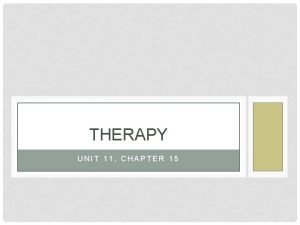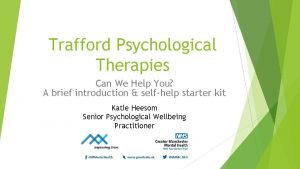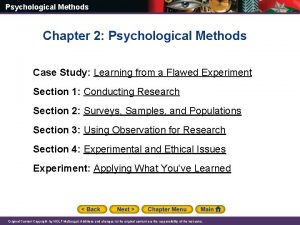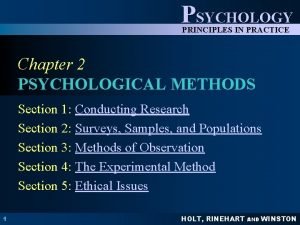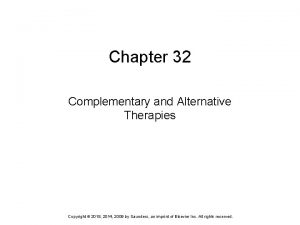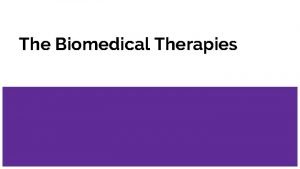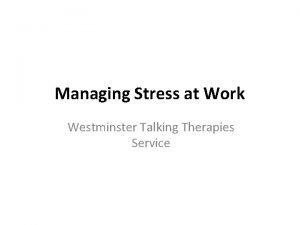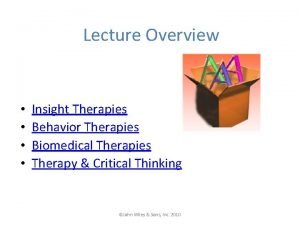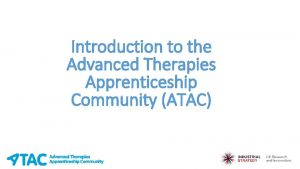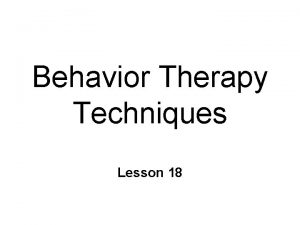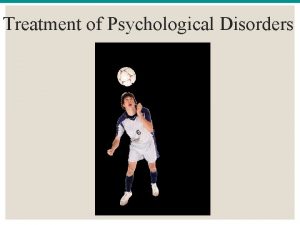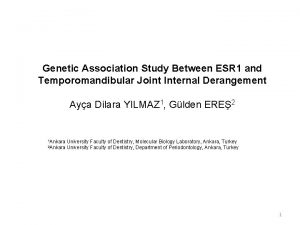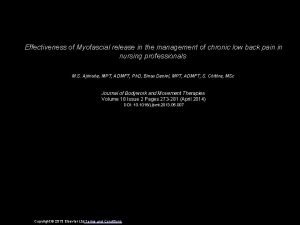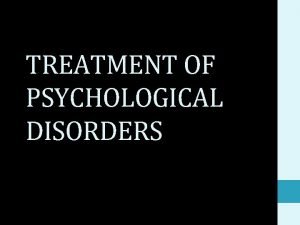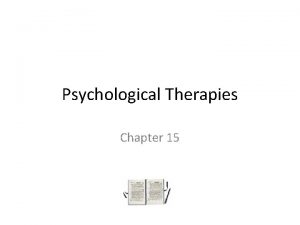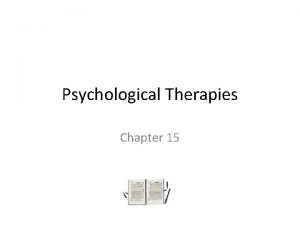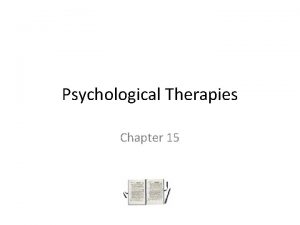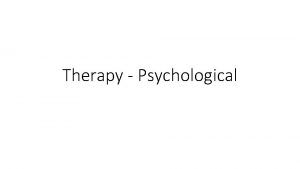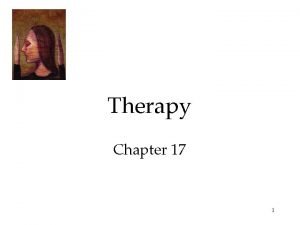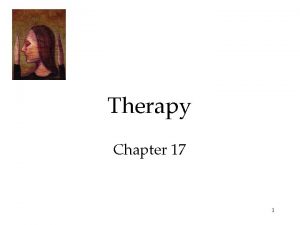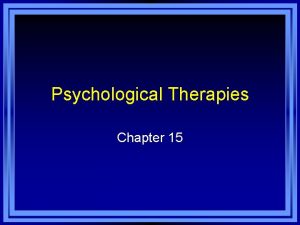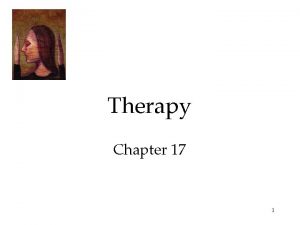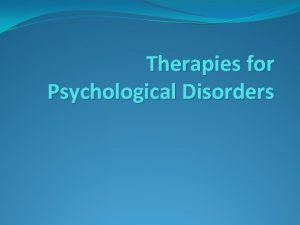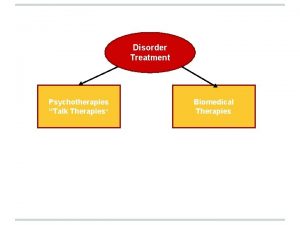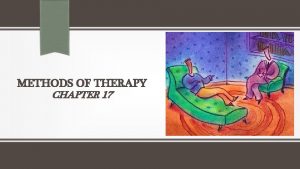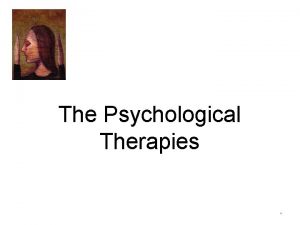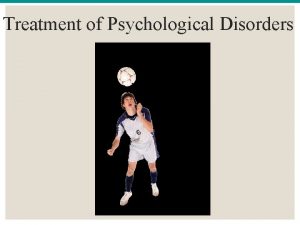Psychological Therapies Chapter 15 Therapy Therapy treatment methods

























- Slides: 25

Psychological Therapies Chapter 15

Therapy • Therapy - treatment methods aimed at making people feel better and function more effectively. • Psychotherapy - therapy for mental disorders in which a person with a problem talks with a psychological professional. – Insight therapies - psychotherapies in which the main goal is helping people to gain insight with respect to their behavior, thoughts, and feelings. – Action therapy - psychotherapy in which the main goal is to change disordered or inappropriate behavior directly. • Biomedical therapy - therapy for mental disorders in which a person with a problem is treated with biological or medical methods to relieve symptoms.

Freud’s Psychoanalysis • Psychoanalysis - an insight therapy based on theory of Freud, emphasizing the revealing of unconscious conflicts. – Dream interpretation • Manifest content – the actual content of one’s dream. • Latent content – the symbolic or hidden meaning of dreams. – Free association – Freudian technique in which a patient was encouraged to talk about anything that came to mind without fear of negative evaluations.

Freud’s Psychoanalysis • Resistance - occurring when a patient becomes reluctant to talk about a certain topic, either changing the subject or becoming silent. • Transference - in psychoanalysis, the tendency for a patient or client to project positive or negative feelings for important people from the past onto therapist.

Psychoanalysis Today • Psychodynamic therapy - a newer and more general term for therapies based on psychoanalysis, with an emphasis on transference, shorter treatment times, and a more direct therapeutic approach. • Nondirective - therapy style in which therapist remains relatively neutral and does not interpret or take direct actions with regard to the client, instead remaining a calm, nonjudgmental listener while the client talks. • Directive - therapy in which therapist actively gives interpretations of a client’s statements and may suggest certain behavior or actions. Psychoanalysis today is more directive.

Roger’s Person-Centered Therapy • • Person-centered therapy - a nondirective insight therapy based on the work of Carl Rogers in which the client does all the talking and therapist listens. Four Elements: 1. 2. 3. 4. Reflection - therapy technique in which therapist restates what the client says rather than interpreting those statements. Unconditional positive regard - referring to the warmth, respect, and accepting atmosphere created by therapist for the client in person-centered therapy. Empathy - the ability of therapist to understand the feelings of the client. Authenticity - the genuine, open, and honest response of therapist to the client.

Gestalt Therapy • Gestalt therapy - form of directive insight therapy in which therapist helps clients to accept all parts of their feelings and subjective experiences, using leading questions and planned experiences such as role-playing. • Try to help clients deal with things in their past that they have denied and will use body language and other nonverbal cues to understand what clients are really saying.

Behavioral Therapy and Classical Conditioning • Behavior therapies - action therapies based on the principles of classical and operant conditioning and aimed at changing disordered behavior without concern for the original causes of such behavior. – Behavior modification or applied behavior analysis – the use of learning techniques to modify or change undesirable behavior and increase desirable behavior.

Behavioral Therapy and Classical Conditioning • Systematic desensitization - behavior technique used to treat phobias, in which a client is asked to make a list of ordered fears and taught to relax while concentrating on those fears. – Counterconditioning - replacing an old conditioned response with a new one by changing the unconditioned stimulus.

Behavioral Therapy and Classical Conditioning • Aversion therapy - form of behavioral therapy in which an undesirable behavior is paired with an aversive stimulus to reduce the frequency of the behavior. • Flooding - technique for treating phobias and other stress disorders in which the person is rapidly and intensely exposed to the fearprovoking situation or object and prevented from making the usual avoidance or escape response.

Behavioral Therapy and Operant Conditioning • Modeling - learning through the observation and imitation of others. – Participant modeling - technique in which a model demonstrates the desired behavior in a step-by-step, gradual process while the client is encouraged to imitate the model. • Reinforcement - the strengthening of a response by following it with a pleasurable consequence or the removal of an unpleasant stimulus.

Behavioral Therapy and Operant Conditioning – Token economy - the use of objects called tokens to reinforce behavior in which the tokens can be accumulated and exchanged for desired items or privileges. – Contingency contract – a formal, written agreement between therapist and client (or teacher and student) in which goals for behavioral change, reinforcements, and penalties are clearly stated. – Extinction – the removal of a reinforcer to reduce the frequency of a behavior.

Cognitive Therapy • Cognitive therapy - therapy in which the focus is on helping clients recognize distortions in their thinking and replace distorted, unrealistic beliefs with more realistic, helpful thoughts. • Cognitive Distortions based on Beck’s Cognitive Therapy: – Arbitrary inference – distortion of thinking in which a person draws a conclusion that is not based on any evidence. – Selective thinking - distortion of thinking in which a person focuses on only one aspect of a situation while ignoring all other relevant aspects.

Cognitive Therapy • Cognitive Distortions: – Overgeneralization - distortion of thinking in which a person draws sweeping conclusions based on only one incident or event and applies those conclusions to events that are unrelated to the original. – Magnification and minimization - distortions of thinking in which a person blows a negative event out of proportion to its importance (magnification) while ignoring relevant positive events (minimization). – Personalization - distortion of thinking in which a person takes responsibility or blame for events that are unconnected to the person.

Cognitive-Behavioral Therapies • Cognitive-behavioral therapy (CBT) - action therapy in which the goal is to help clients overcome problems by learning to think more rationally and logically. • Three goals: – Relieve the symptoms and solve the problems. – To develop strategies for solving future problems. – To help change irrational, distorted thinking.

Rational-Emotive Therapy • Rational-emotive behavior therapy (REBT) cognitive-behavioral therapy in which clients are directly challenged in their irrational beliefs and helped to restructure their thinking into more rational belief statements.


Group Therapy • Advantages: – Low cost. – Exposure to other people with similar problems, social interaction with others. – Social and emotional support from people with similar disorders or problems.

Group Therapy • Disadvantages: – Need to share therapist’s time with others in the group. – Lack of a private setting in which to reveal concerns. – Possibility that shy people will not be able to speak up within a group setting. – Inability of people with severe disorders to tolerate being in a group.

Effectiveness of Psychotherapy • Psychotherapy is more effective than no treatment at all. • From 75 to 90 percent of people who receive therapy improve, the longer a person stays in therapy the better the improvement, and psychotherapy works as well alone as with drugs. • Some types of psychotherapy are more effective for certain types of problems, and no one psychotherapy method is effective for all problems. – Effective therapy should be matched to the particular client and the particular problem,

Effectiveness of Psychotherapy • Eclectic therapies - therapy style that results from combining elements of several different therapy techniques. • Therapeutic alliance - the relationship between therapist and client that develops as a warm, caring, accepting relationship characterized by empathy, mutual respect, and understanding.

Culture and Psychotherapy • When the culture, ethnic group, or gender of therapist and the client differs, misunderstandings and misinterpretations can occur. • Four barriers to effective psychotherapy that exist when the backgrounds of client and therapist differ are language, cultural values, social class, and nonverbal communication.

Drug Treatments • Biomedical therapies – therapies that directly affect the biological functioning of the body and brain. • Psychopharmacology - the use of drugs to control or relieve the symptoms of psychological disorders. – Antipsychotic drugs - drugs used to treat psychotic symptoms such as delusions, hallucinations, and other bizarre behavior.

Drug Treatments – Antianxiety drugs - drugs used to treat and calm anxiety reactions, typically minor tranquilizers. – Antimanic drugs - used to treat bipolar disorder and include lithium and certain anticonvulsant drugs. – Antidepressant drugs - drugs used to treat depression and anxiety. Menu

Danger of Treating Children with Antidepressants • All but one antidepressant drug has been associated with an increased risk of suicide when used to treat depression in children and adolescents. – Prozac, the one safe antidepressant for children and adolescents, has been found to be more effective when combined with psychotherapy.
 Systematic desensitization therapy
Systematic desensitization therapy Trafford psychological therapies
Trafford psychological therapies Trafford psychological therapies
Trafford psychological therapies Trafford psychological therapies
Trafford psychological therapies Trafford psychological therapies
Trafford psychological therapies Single blind study
Single blind study Psychology principles in practice
Psychology principles in practice Chapter 32 complementary and alternative therapies
Chapter 32 complementary and alternative therapies Chapter 19 methods of therapy
Chapter 19 methods of therapy Samic reality therapy
Samic reality therapy Direct wax pattern technique
Direct wax pattern technique Module 73 the biomedical therapies
Module 73 the biomedical therapies The biomedical treatment most widely used today is
The biomedical treatment most widely used today is Stiriti ayur therapies
Stiriti ayur therapies Talking therapies westminster
Talking therapies westminster Biomedical therapy techniques
Biomedical therapy techniques Advanced therapies apprenticeship community
Advanced therapies apprenticeship community Flooding therapy
Flooding therapy Humanistic therapies aim to boost
Humanistic therapies aim to boost Psychoanalytic vs humanistic
Psychoanalytic vs humanistic Biomedical therapy definition
Biomedical therapy definition Astellas gene therapies
Astellas gene therapies Bodywork and movement therapies
Bodywork and movement therapies Bodywork and movement therapies
Bodywork and movement therapies Insight therapies involve verbal interactions
Insight therapies involve verbal interactions Therapies that directly affect the biological functioning
Therapies that directly affect the biological functioning
